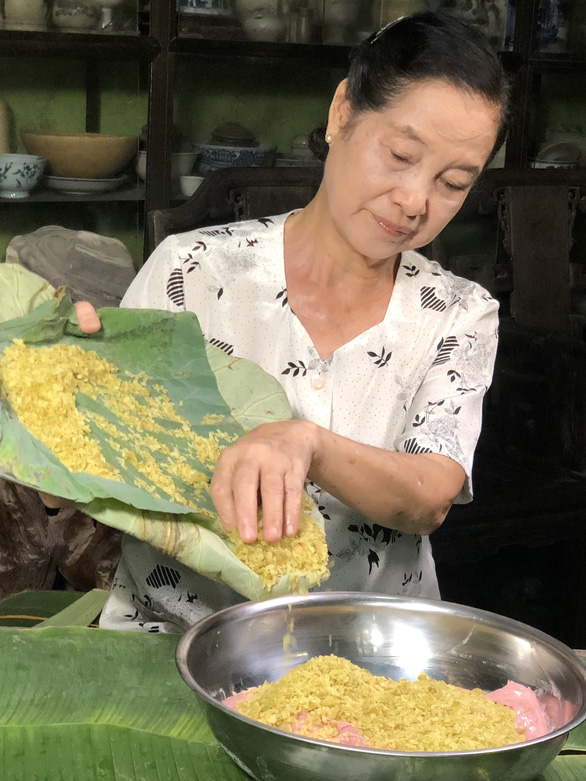It is not hard to find a shop selling the 'cha lua' originating in Uoc Le Village in Hanoi. However, these products’ tastes vary and usually do not live up to the stories about the specialty of the capital’s outlying ancient village.
Uoc Le villager, meritorious artist Ngoc Tan -- recognized by the Vietnamese audience as 'the nation’s mother' in a TV series -- said the 'cha lua' of yesterday tasted wonderful as they were cooked from fresh meat only.
Working as an actress for the Hanoi Drama Theater, Tan thought she 'escaped' the inexorable link she had with 'cha lua' making.
But a marriage to a husband whose mother is famous for a 'cha lua' ('gio lua') shop in Hanoi’s Old Quarter brought her back to the tradition, rekindling her love for the village’s renowned dish.
Uoc Le Village’s quintessence
Tan’s mother-in-law was committed to making 'cha lua' by hand.
Being a daughter-in-law of one of Hanoi’s most famous 'cha lua'-making artisans, Tan inherits all the techniques and tips in developing premium products.
Freshly butchered ham has to be cooled down a little bit before having skin, fat, and tendon removed. Lean meat is then hand-pounded in a stone mortar.
After that, fish sauce and salt are added. No additive is used to preserve the authentic taste of the meat.
The mixture is then wrapped in banana leaves and boiled. The final product’s texture should be crunchy with tiny air holes found on its surface.
Uoc Le villagers have brought their techniques to places far and wide. They were among nearly one million northerners migrating to southern Vietnam in 1954.
In the south, they did not hand-pound meat but used grounding machines made in Germany for the step then transferred the technology back to the north.
Compared to the traditional way, it helped to raise productivity yet compromised tastes.
“Many 'cha lua'-makers use food colourings to make their products look more tempting," said Tan.
"My mother-in-law falls in love with the natural, humble colors of 'cha lua.'
"Looking at Uoc Le Village’s 'cha lua,' I can feel how much love and effort my ancestors put into making the specialty.”
Tan retired from the theater in 1990 and started starring in dramas as a freelancer.
During breaks waiting for film crews to prepare scenes, she came to Hoe Nhai Market to help her mother-in-law sell 'cha lua.'
When her mother-in-law became weaker and could no longer run the shop, Tan carried baskets of 'cha lua' to sell along the Old Quarter’s lanes, such as Hang Than, Hoe Nha, Nguyen Truong To, Hang Luoc, and Hang Cot.
Until now, several people living in that area could still talk about Tan as a popular vendor.

A lifeline
Tan said some generations of her husband’s family lived by making 'cha lua.'
“This job will never leave us hungry. We have to nurture and express gratitude for it,” Tan recalled her mother-in-law saying.
In the 1940s and 1950s, her parents-in-law moved from Uoc Le to the city center and rented a small house on O Cau Den Street to sell their homemade 'cha lua.'
At the time, there were not many Uoc Le Village-style 'cha lua' shops in the metropolitan area like now. Therefore, they could make great profits from the business.
In 1945-46, during the chaotic days of war, Hanoians had to evacuate to other areas. The couple brought their new-born son – Tan’s husband – and cooking tools to Phu Xuyen in the old Ha Tay Province (now a district of Hanoi) to continue making 'cha lua.'
Traveling back and forth between the city center and outlying districts to escape the war for years, they always carried along a mortar and pestle – their most valuable assets.
In 1973, they bought a house on Nguyen Truong To Street and devoted the rest of their life to perfecting the art of 'cha lua'-making.
In Tan’s memory, the image of her mother-in-law carrying a basket of 'cha lua' to deliver on the Old Quarter’s streets never fades.
“I am both a professional actress and 'cha lua'-maker. Looking back, my family overcame all ups and downs thanks to this job,” she said.
In early 2000, due to health problems, Tan discontinued making 'cha lua.'
It took her some time to find successors – one of her three daughters-in-law.
She is trying to develop the brand name of Lady Tan’s 'cha lua,' just like the way Tan nurtured the quintessence of her husband’s family.
Like us on Facebook or follow us on Twitter to get the latest news about Vietnam!



























